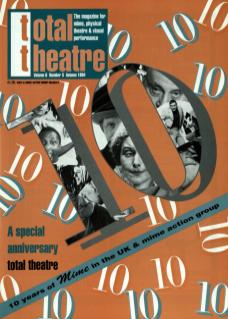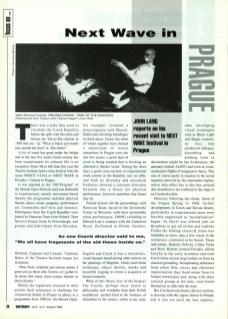There was a joke that used to circulate in the Czech Republic before the split with Slovakia and before the Velvet Revolution in 1989 that ran:
Q: ‘What is black and stands just outside the door?’
A: ‘The future.’
A lot of water has gone under the bridge and in the last five years Czech society has been transformed; its cultural life is no exception. From 4-6 June this year the Theatre Institute held a mini-festival with the name Pristi Vlna Next Wave at Divadlo v Celetne in Prague.
It was planned as the ‘Off-Program’ of the Mozart Open Festival, and was dedicated to experimental, mainly movement-based theatre; the programme included physical theatre, dance, mime, puppetry, performance art, Commedia dell'Arte, and Ionesco. Participants from the Czech Republic were joined by Parravan Teatr from Poland, Teatr Novovo Fronta from St Petersburgh, and groups and individuals from Slovakia, Holland, England and Canada. Vladimir Hulec of the Theatre Institute began his invitation:
‘Dear fools, madmen and serious artists, I greet you as those who I know, or I gather, to be those that enjoy close-contact theatre or direct theatre.’
Whilst the organisers stressed in their articles their reluctance to challenge the commercial theatre in Prague (a glance at a programme from 1990 for the Mozart Open, for example, revealed a preoccupation with Mozart, Kafka and, hovering broodingly in third place, Faust; the three of whom together have formed a triumvirate of tourist attractions in Prague over the last few years), a great deal of work is being created that is forming an alternative theatre scene. During the three days a good cross-section of experimental work current in the Republic was on offer, and both its diversity and uncynical freshness showed a constant direction forwards into a future for physical performance, however unwritten that future may be.
Poland kicked off the proceedings with Parravan Teatr, based in the Grotowski Centre in Wroclaw, with their memorably titled performance, Dong (alluding to Edward Lear's creature with the Luminous Nose). Performed in Polish, German, English and Czech it was a surrealistic, visual banquet based among other sources on the paintings of Magritte, which used mime technique, object theatre, masks and beautiful staging to create a sequence of bizarre fantasies.
What of this Slavic love of the bizarre? The Czechs, perhaps more drawn to philosophy and wordplay than their Polish neighbours, pushed hard at the frontiers of absurdism in the sixties, whilst at the same time developing visual techniques such as Black Light and Magic Lantern. At best this produced oblique, disturbing and probing work (a descendant might be Jan Svakmayer, the animator behind Alice) and even at worst, unashamed flights of imaginative fancy. This was of course partly in reaction to the social negation enforced by the communist regime, whose after-effect has to this day ensured that absurdism is not confined to the stage in ex-Czechoslovakia.
However, following the clamp down of the Prague Spring in 1968, further developments in Czech and Slovak theatre, particularly in experimental areas were forcibly suppressed as ‘normalisation’ began. As Havel was offered jobs on Broadway to get rid of him and Ladislav Fialka the leading classical mime was forbidden to leave, only a few voices in the wilderness continued to be heard. Three individuals, Boleslav Polivka, Ctibor Turba and Boris Hybner formed Divadlo Alfred Jarryho in the early seventies and took Czech mime several steps further on from its classical grounding. Incorporating influences from silent film, circus and character improvisation they freed mime from its formal stereotypes and, along with other satirical groups at the time, soon found themselves at odds with the state.
The Czechs, perhaps more drawn to philosophy and wordplay than their Polish neighbours, pushed hard at the frontiers of absurdism in the sixties, whilst at the same time developing visual techniques such as Black Light and Magic Lantern.
But Czechoslovak theatre did not continue to develop with the vigour shown in Poland, and it was not until the late eighties, particularly as the Berlin Wall fell, that a new wave broke in Prague, represented at this festival by Jumping Hamada from Pardubice in Bohemia and by Teatr Novovo Fronta, a Czech/Russian partnership. Here is Michal Zahradnik of Jumping Hamada (my translation): ‘The way which we have set out on has no name, and can have no name. A way of contact, of going together. So there are stones, dreams, lightness, time, desire, place, meetings, murder, dance, hopes, escape. The journey is along the theme of names, and it respects their laws... a meeting is an act of change. A performance? An agreed world. A crossroads on the journey, and maybe – an illumination of reality.’
The group is a trio, accompanied by live musicians. At Next Wave they played once in the indoor theatre space and once outside in the Baroque courtyard formed by the theatre and the Institute. It is dance-theatre, if a label must be found, ritualistic and highly corporeal. Much use is made of textures, movements and sounds not only of the human body but of surroundings and of objects: willow reeds, bamboo canes, a wooden egg, heavy pots of water, stones and grasses. Though sometimes loose in structure and often obscure in meaning, the general effect is of watching three figures discover the physical world of their own bodies and of texture and form around them; stone surfaces, running water, different temperatures in light and shade and so on. This involved adventurous use of the site with clambering around walls, alcoves and banisters. This group, formed around 1990, owe their main influence to Derevo, a group from St. Petersburg who were resident in Prague from that time until 1992 when they returned to Russia. Under the firm hand of the group's leader, Anton Adasinsky, they were based while in Prague at Studio Rampa, an experimental theatre space now somewhat upmarketed to the Duncan Centre where dance and mime classes are held. The name Derevo comes from the Russian word for wood, and the central force of their work is to return to the basic form of all things – what Lao Tzu might have called the uncarved block. Always a keen perpetrator of notoriety and controversy, Adasinsky commented on performances where, for example, performers worked almost naked in the snow on winter evenings, and on the collective nature of Derevo and its followers (generally with shaved heads and in many cases robes) by stressing that their work was a movement back to zero: stripping away levels of theatricality, notions of art and political oppressions that had become, certainly for the group members, meaningless. The physical power, rhythmic control and dedication of Derevo's work, for example in Man Licking the Bottom of a Boat, which I saw in 1992, is undeniably extraordinary. Both Poor Theatre and dance, they are unafraid to express themselves through puppetry, mime and mask-work if the medium works. Their residency in Prague, though at times growing to the status of a cult, had a profound effect on young Czech performers who were working from the background I have sketched very briefly above. The urge to find new truths and personal emancipation was and indeed is very strong after the revolutions. As one Czech director said to me, ‘We all have fragments of the old times inside us.’ Teatr Novovo Fronta's performance, Vremja Durak explored very closely the psychological changes taking place in Russia, as seen in two clown/grotesques. Moments of this show, filled with faultless movement, drew cheers from the mainly Czech audience, not only from admiration but from recognition of meaning.
A partnership of two Vaclavs is at the helm of the Czech Republic – Havel as President and moral/cultural guardian, and Klaus as Prime Minister and successful economist. Battles are of course being fought for support for the arts and particularly theatre which has a much higher profile in the minds of the public than in this country. One theatre of historic importance in Prague's theatre history has become an amusement arcade. On the other hand, Prague is fortunate in attracting a wide variety of theatre practitioners of world importance: since 1989, Bread and Puppet Theatre, Peter Brook, Robert Wilson, Kantor's Cricot 2, Min Tanaka and Butoh Theatre, this year have all visited the city. Clearly a new wave is rolling forward into the future, and if Czechs are able to take in its effects and create exciting work from them, they might well make sure that the future doesn't turn out to be so black after all.
With many thanks to Vladimir Hules, Festival Director.


